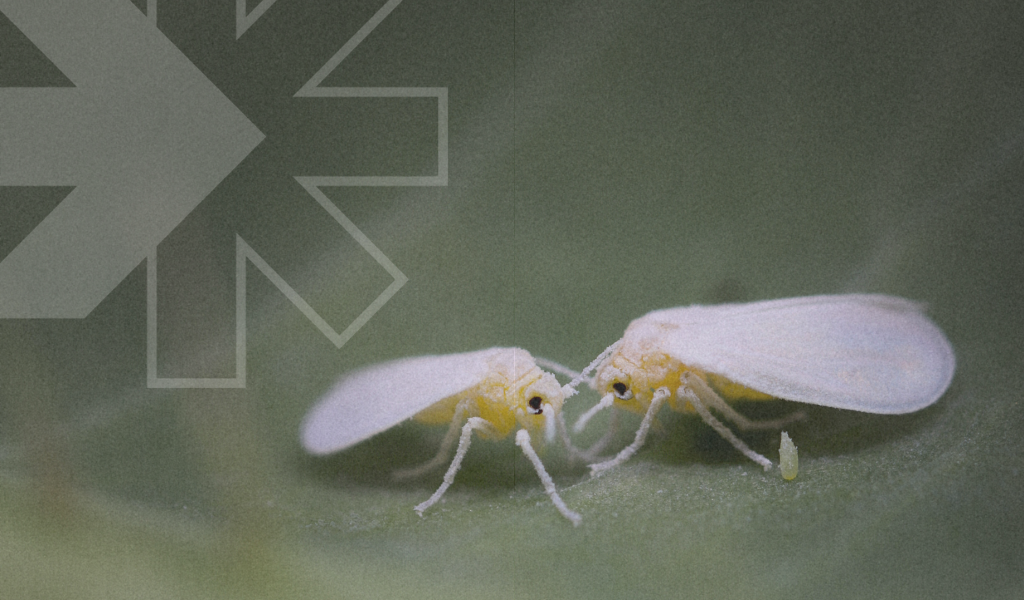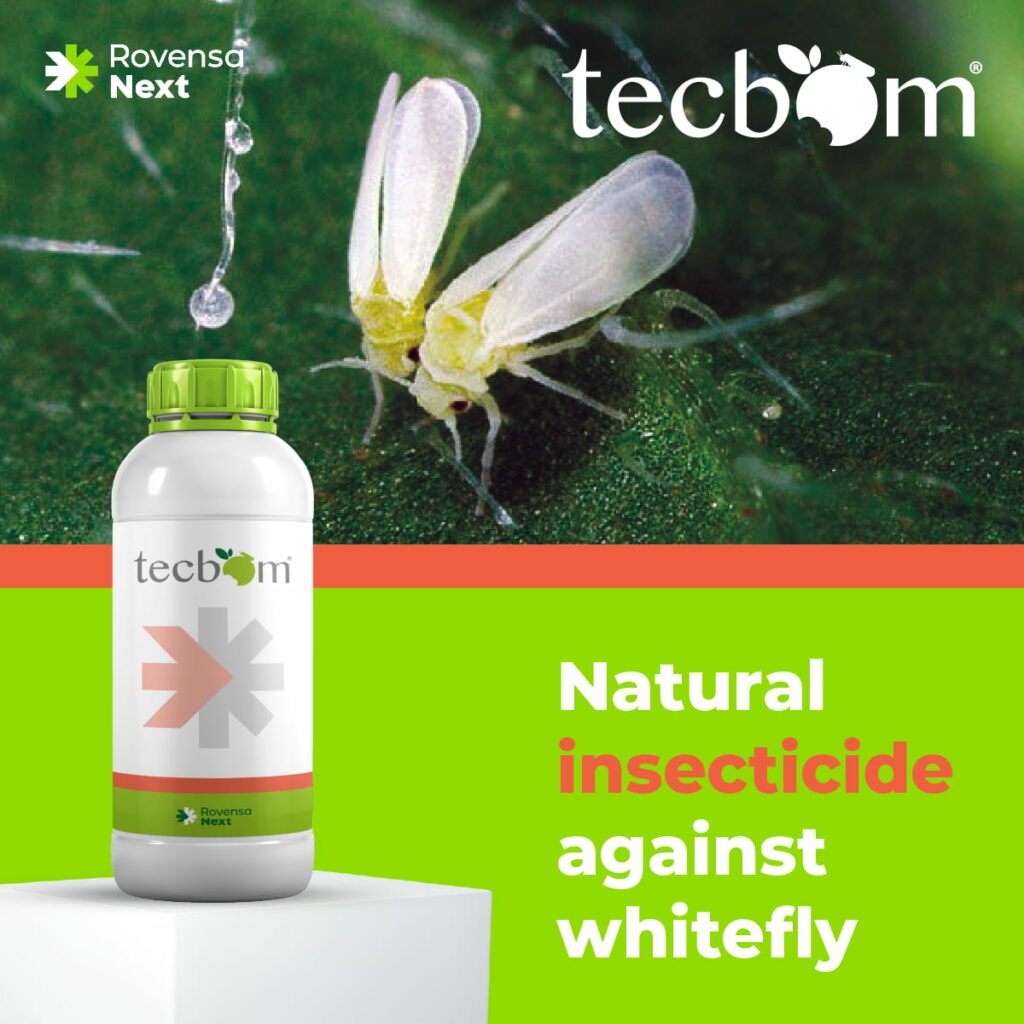Whiteflies, which are members of the Aleyrodidae family, are one of the world’s most destructive insect pests in vegetables and ornamental crops.¹ Over 1,500 species of these homopterous insects, which possess sucking mouthparts that extract sap from plants, have been identified, including Bemisia tabaci and Trialeurodes vaporariorum. Their feeding habits can inflict considerable harm on crops like beans, cucumbers, aubergines, potatoes, ash gourds, cabbages, sweet potatoes, lettuces and tomatoes. The damage caused can lead to compromised fruit quality, bringing losses estimated at hundreds of millions of dollars every year.²
Identifying a whitefly infestation
Prioritising prevention and ensuring proficient management are key to dealing with whitefly infestations. It is crucial to regularly inspect the undersides of leaves for early detection as swift action at this time can prevent widespread infestation.
Safeguarding crops from whitefly damage requires a proactive approach encompassing prevention, vigilance and effective management practices. By understanding the whitefly’s life cycle, the potential damage it can cause, and the deployment of strategic measures, good plant health can be maintained, ensuring bountiful, high-quality fruit yields.
Damage and losses caused by whitefly
Whitefly inflicts minor to severe economic damage, leading to annual global losses that can reach billions of dollars across multiple crops.
Damage caused by feeding
Whitefly nymphs can inject enzymes into plants, inducing alterations in plant physiology. This process can lead to irregular fruit ripening and delayed internal coloration. Furthermore, the honeydew produced by whiteflies serves as a substrate for sooty mould development on both leaves and fruits, leading to diminished photosynthetic activity.
These effects may have detrimental consequences on the quality of agricultural yields. Furthermore, the feeding behaviour of whiteflies on leaves can cause yellowing and crumpling, ultimately resulting in stunted plant growth and the development of malformed fruits.
Whiteflies as a virus vector
Whiteflies can transmit over 200 plant viruses, predominantly associated with the Begomovirus, Carlavirus, Crinivirus, Ipomovirus and Torradovirus genera.³ All these viruses are directly identified as the main cause of yield losses in crops, ranging from 20% to 100% of total losses, and representing millions of dollars.⁴
Whitefly resistance and changing climate concerns
The extensive utilisation of chemical pesticides has significantly raised widespread resistance to traditional pesticides globally. Overuse of synthetic chemical pesticides also brings severe health risks to users and consumers as well as destroying other non-target organisms.⁵
This pest reproduces throughout the year in areas with warm climates and mild temperatures (especially in regions with mild winters). Therefore, evidence of climate change has increased concern about the greater persistence of this pest and its proliferation in new regions.⁶
- Temperature changes. As global temperatures rise, particularly in tropical and subtropical regions, there will be more favourable conditions for whitefly populations to expand, leading to increased infestations.
- Altered plant hosts. Changes in climate may affect the distribution and abundance of host plants.
- Increased reproduction rates. Warmer temperatures may accelerate the reproduction rates of whiteflies, spawning more generations in a shorter timeframe.
- Spread of vector-borne diseases. Whiteflies are known vectors of various plant viruses. Climate change may influence the distribution of these viruses and the dynamics of disease transmission, posing additional challenges to crop health.
- Pest management challenges. Whiteflies have developed greater resistance to insecticides across different regions of the world as a consequence of years of chemical pesticide abuse.
Dealing with whitefly: Tecbom® the natural bioinsecticide based on 100% naturally sourced saponified vegetable oleins
At Rovensa Next, we understand growers’ real day-to-day sustainability challenges. We work hard to develop innovative biosolutions so they can protect their crops without compromising on performance whilst complying with the latest regulations.
Tecbom® is a natural contact-acting bioinsecticide which is ideal to combat whitefly. This biosolution is highly effective in controlling the pest while fully protecting the plant, thanks to its specific technology.
Tecbom® acts by dissolving the chitin or protective layer that covers the exoskeleton of the whitefly, altering its cell membranes, and causing death by suffocation and dehydration.
Tecbom®’s unique innovative formula produces plant micelles when it comes into contact with water. This reduces water surface tension and eliminates impurity particles, conferring a strengthening, wetting and purifying effect.*
- Powerful contact action without creating resistance.
- Highly effective at low doses in combatting whitefly in a broad range of crops.
- Respects beneficial insects and is not phytotoxic to the plant.
- No pre-harvest period
- Improves adhesion for other treatments.
- Lowers water surface tension.
Contact the Rovensa Next team through our Contact form for further information on how to deal with whitefly.
* Rovensa Next is a global business unit that delivers solutions for agriculture around the globe. The information shared here may vary depending on your location. Please contact us using our Contact form to confirm whether the product is available in your country, or should you have any queries or require any additional information. Thank you.
- Perring T.M., Stansly P.A., Liu T.X., Smith H.A., Andreason S.A. Whiteflies: Biology, ecology, and management. In: Wakil W., Brust G.E., Perring T.M., editors. Sustainable Management of Arthropod Pests of Tomato. Academic Press; Cambridge, MA, USA: Elsevier; Amsterdam, The Netherlands: 2018. pp. 73–110.
- John L. Capinera (11 August 2008). Encyclopedia of Entomology. Springer Science & Business Media. pp. 2944–. ISBN 978-1-4020-6242-1.
- Jones D.R. Plant viruses transmitted by whiteflies. Eur. J. Plant Pathol. 2003;109:195–219. doi: 10.1023/A:1022846630513.
- Gangwar R.K., Charu G. Lifecycle, distribution, nature of damage and economic importance of whitefly, Bemisia tabaci (Gennadius) Acta Sci. Agric. 2018;2:36–39.
- kinner M., Parker B.L., Kim J.S. Integrated Pest Management: Current Concepts and Ecological Perspective. Elsevier Inc.; Amsterdam, The Netherlands: 2013. Role of entomopathogenic fungi in integrated pest management; pp. 109–191.
- Saghafipour A, Zahraei-Ramazani A, Vatandoost H, Asadollahi A, Fouladi-Fard R, Hamta A, Hasanwand A. Relationship between Some Environmental and Climatic Factors on Outbreak of Whiteflies, the Human Annoying Insects. J Arthropod Borne Dis. 2020 Mar 31;14(1):78-87. doi: 10.18502/jad.v14i1.2714. PMID: 32766351; PMCID: PMC7382691.
















